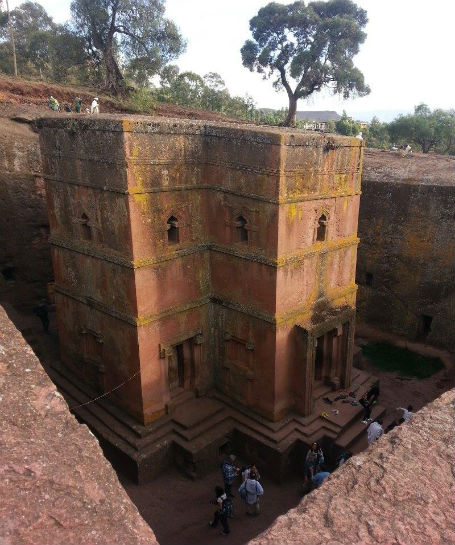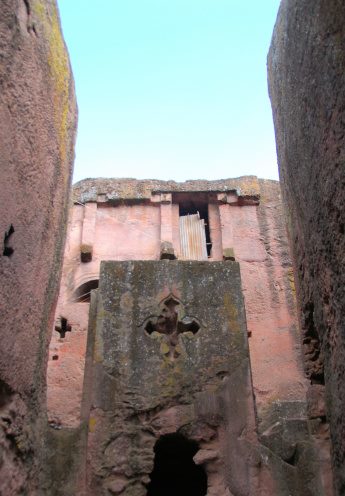Sightseeing Churches in Lalibela
"The ultimate in rock church design.... One is amazed at the technical skill, the material resources and the continuity of effort which such vast undertakings imply...I swear by God, in whose power I am, that all that is written is the truth, and there is much more than I have already written, and I have left it that they may not tax me with its being falsehood."
This is the conclusion made by the first European to visit Lalibela, Francisco Alvarez.
Lalibela’s churches are divided into two clusters, separated by the Jordan River- one local legend has it that the river was given this name after king Lalibela returned from Jerusalem.
The northern cluster comprises six churches: Bet Medhane Alem, Bet Mariam, Bet Meskel, Bet Danaghel, Bet Michael, Bet Gologota and the Selassie chapel.
The southern cluster consists of four churches: Bet Emanuel, Bet Mercurios, Bet Aba Libanos, Bet Lehem and Bet Gebriel Rafael.
The eleventh church, Bet Giorgis stands discret from the two main clusters.


The various churches of Lalibela were constructed using one of two different methods. Bet Giorgis and the churches in the northwest cluster are mostly excavated from below the ground, and are surrounded by courtyards and trenches, so that they mimic normal buildings. Several of these churches are monoliths or three quarter monoliths- free from the surrounding rock on three or four sides, it is a style of excavation that is unique to Ethiopia.
The churches of the southwest cluster are similar to many churches in Tigray, in that most of them were excavated from a vertical rock face by exploiting existing caves or cracks in the rock. The style is remarkably similar to the numerous rock hewn churches of Tigray, but the sheer masterpiece in craftsmanship is quite wonderful. These churches were so perfect that they were considered by some as ‘The Eighth Wonder of the World’, and became one of UNESCO’s world heritage sites.
Lalibela is still revered as a saint by Ethiopian Orthodox Christians. His tomb and the city itself draw thousands of pilgrims every year.
The various churches of Lalibela were constructed using one of two different methods. Bet Giorgis and the churches in the northwest cluster are mostly excavated from below the ground, and are surrounded by courtyards and trenches, so that they mimic normal buildings. Several of these churches are monoliths or three quarter monoliths- free from the surrounding rock on three or four sides, it is a style of excavation that is unique to Ethiopia.
The churches of the southwest cluster are similar to many churches in Tigray, in that most of them were excavated from a vertical rock face by exploiting existing caves or cracks in the rock. The style is remarkably similar to the numerous rock hewn churches of Tigray, but the sheer masterpiece in craftsmanship is quite wonderful. These churches were so perfect that they were considered by some as ‘The Eighth Wonder of the World’, and became one of UNESCO’s world heritage sites.
Lalibela is still revered as a saint by Ethiopian Orthodox Christians. His tomb and the city itself draw thousands of pilgrims every year.

Monastery and churches outside of Lalibela
The mountains around Lalibela are studded with medieval monasteries and churches, many of which are very different to their Lalibela counterparts.
Nakuta La’ab is traditionally very popular with backpackers, since it can be reached on foot without a guide, while the mule ride to Asheton Maryam and Yemerhan Kerstose also form a Straightforward day trip out of Lalibela.

Asheton Mariam
Asheteon Mariam lies at an altitude of almost 4,000m on the high mountain overlookinע Lalibela. This monastery is also associated with king Nakuta La’ab who most probably founded it and who may even be buried in the chapel. The church is carved out of a cliff face, and the execution is rougher than at most other churches in and around Lalibela. Asheton Maryam houses some interesting crosses and other church treasures, but the excursion is just as remarkable for the church’s setting and the views on the way up.
Nakuta La’ab Monastery
The monastery of Nakuta La’ab named after its constructor, the nephew and successor of king Lalibela. One tradition has it that Nakuta La’ab ruled from this church, which he called Qoqhena, during an 18 month break in Lalibela’s monarchy, another that he took refuge here after he was deposed. The church is built around a shallow cave in which several holy pools are fed by natural springs and it has many treasure, some of which are claimed to have belonged to Nakuta La’ab himself. This includes paintings, crosses and an illuminated leather Bible. One advantage over the churches in town is that the treasures are brought out
into the open where they can be examined in decent light.
Yemereane Kerstose
The church was built by its namesake, Yemerehanna Kirstos, the third Zagwe ruler and a predecessor of King Lalibela, recorded as ascending to the throne in AD 1087 and ruling for about 40 years. The church is situated at an altitude of around 2,700 m and protected by an unflattering modern outer wall. It’s an old builtup church within alternating layers of wood and whitewashed marble that give it the appearance of a gigantic layered chocolate cream cake. Among many interesting architectural features are the cruciform curved windows, an etched
wood paneled roof, a coffer ceiling with inlaid hexagons, and a large dome over the sanctuary.

